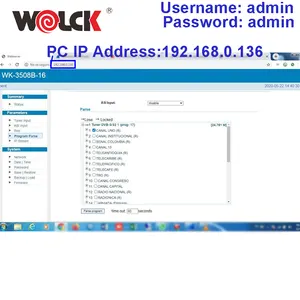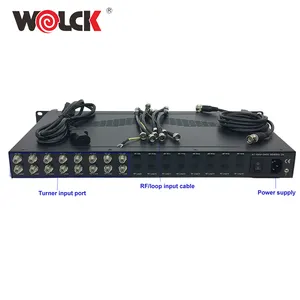
All categories
Featured selections
Trade Assurance
Buyer Central
Help Center
Get the app
Become a supplier

(660 products available)




















































A DVB S2 IRD receiver is used for satellite transmission that meets the digital video broadcasting standard. Its mode of operation is similar to that of a cable TV receiver. This kind of receiver can use a conditional access system (CAS) for decrypting channels that are encrypted. Some receivers have a built-in CAS, while others use an external CAS integrated into the server. IRD receivers can be divided into different categories depending on their capabilities.
1. Basic Model:
Basic model IRD receivers can only decode two standard-definition MPEG-2 and MPEG-4 formats. They are used for receiving digital satellite television and are often called entry-level receivers. These receivers provide essential satellite TV viewing without any additional features. The audience segment that mainly uses these receivers is cost-conscious users who only need fundamental satellite TV. The straightforward interface on basic models makes it easy for users to install and operate these receivers.
2. Enhanced Model:
The enhanced model can decode five formats, which include standard-definition, high-definition, HEVC, and MPEG-2. In addition to the capabilities of the basic model, enhanced models can access a wider variety of channels. More high-definition channels are included in the line-up of these receivers. Enhanced models have a better picture quality for those premium channel packages that are in high-definition. The interface of enhanced model receivers is more sophisticated, and they give users a better-viewing experience.
3. Advanced Model with CI Slot:
CI slots are common features in many IRD receiver models. The CI slot allows viewers to use a conditional access module (CAM) and smart card for decrypting pay-TV channels. The width of the CI slot is the same as that of the PCMCIA interface. Its location is usually at the front or side of the receiver. The CAM is inserted into the CI slot, and the smart card is inserted into the CAM. Users are able to watch encrypted channels once the CAM and CI slot work together to decrypt the signal. Many users prefer using a CI slot instead of having an in-built CAS because it gives them more flexibility. They can choose the CAM and specification that meets their requirements.
4. Professional Model:
Professional model receivers can decode ten formats, including standard and high definitions. They can decode various video formats, which makes them versatile. These professional models have more advanced features, including multiple output connections, closed caption support and Ethernet input port. Some of the output connections are AV, HDMI and SDI. The receivers offer professional-quality video output for broadcast applications. They have capabilities that support professional video production, which include time code, embedded audio and metadata carriage.
The DVB-S2 FTA satellite TV receivers have many features that improve user experience and viewing. Here are some of them:
Picture-in-Picture (PIP)
The PIP feature allows viewers to watch two different satellite channels at the same time. A small window and a larger channel with another as the background are created on the screen. So, there is no need to change between channels to see the program of interest to a user.
Sleek and Modern Design
The DVB-S2 receivers come in neat and compact designs that take up less space. Some have LED display panels that show the channel number and other useful information like the time. They also have smooth and stylish exteriors that look good in any setting. Plus, some DVB-S2 satellite TV receivers have easily removable panels for adding hard drives.
USB Connectivity
Many DVB-S2 receivers have USB ports that allow users to connect memory sticks. They enable users to save their favorite TV programs and watch them later at their convenience.
Parental Control
The set top box receiver gives parents the power to control what their children watch. It allows them to block certain channels and programs that are not fit for children. The feature gives parents peace of mind while their children watch TV.
Electronic Program Guide (EPG)
DVB-S2 satellite receivers have a program guide feature that makes finding programs easier. The EPG display contains a list of all the programs with information about the time they start and a brief description. Users can scroll through the schedule to see the programs of interest.
HDMI Connectivity
A lot of recent TVs come with HDMI ports. So, the DVB-S2 receivers have HDMI ports that allow users to connect the receiver to the TV set for a better viewing experience. The connection delivers clearer pictures and sharper sounds for true satellite entertainment.
The DVB-S2 IRD receiver has a broad application range. It can be used in the following scenarios:
Satellite TV Broadcasting
The DVB-S2 satellite receiver can decode digital satellite signals for viewing. It provides access to various TV channels, such as sports, movies, and news. This typically replaces cable or direct broadcast satellite TV for subscribers. It is an eco-friendly technology that helps cut down on paper and energy waste in the broadcasting industry.
Data and Content Distribution
In satellite broadcasting systems, information and data are sent to many receivers via a satellite beam. The data could be internet protocol packets, digital audio or video, or any other type. A DVB-S2 IRD receiver can receive and decode this information for further use. So, whether it's software updates for set-top boxes, multimedia broadcasts, or internet connectivity, the IRD plays a role in providing diversified content and services through a single satellite link.
Emergency and Municipal Services
Satellite receivers facilitate efficient communication in critical situations where traditional networks may fail. They enable the delivery of emergency alerts, weather updates, and information to remote areas during disasters, ensuring public safety and timely response coordination. Military organizations also use satellite communication systems, which depend on IRD receivers, to share intelligence data in real-time, conduct surveillance, and maintain strategic connectivity in remote or hostile environments.
Risk and Financial Analysis
DVB-S2 systems can access specialized financial and market information channels or feeds offering real-time data on stock prices, commodities, and other economic indicators. Business analytics might use these data feeds to help them make smart decisions based on the market situation. In remote or rural areas with limited internet access, satellite receivers provide a way to view financial news and data, ensuring that investors and businesses can stay up to speed with market trends and make informed choices.
When purchasing TV receivers for business, finding receivers that can meet various customers' needs and budgets is essential. The following are aspects to consider when buying IRD receivers.
Consumer vs. Professional Receivers
Professional receivers have numerous features that enhance channel distribution and output quality. They are mainly used in broadcast studios and cable TV companies. Consumer-grade receivers are common among home users. Such receivers may not have elaborate features like professional receivers.
Number of Tuners
The number of tuners a receiver has determines how many channels one can watch or record simultaneously. For instance, a receiver with two tuners can watch two different channels simultaneously and record one of them. Ideally, the more the number of tuners, the more flexible and simultaneous viewing and recording are possible.
Advanced Features
Business owners should look for features that can entice customers and boost sales. Such features include Electronic Program Guides (EPGs) that promote smooth navigation of TV schedules, Program and Time Shift Service (PVRTS) that allows users to pause live TV and play programs, and Play Video on Demand (VOD) that enables users to access content whenever they request it.
Other features that enhance user experience are Conditional Access (CA) for content protection and access control, Over-the-top(OTT) streaming for internet-based content, and Networked Media Playback that allows users to stream media from connected devices.
Number of Outputs
The receiver's outputs determine the number of devices to which the receiver can connect. For instance, an HDMI output allows connection to modern TVs, while an optical output enables connection to surround sound systems. Other receivers' outputs are coaxial and analog, which provide connection to TVs and audio systems that have no digital inputs.
Upgradable System
Business owners should consider system upgradeability. Upgradeability allows users to get the updated features, enhanced performance, advancements like 4K support, and improved functionalities while keeping the existing hardware.
Unified Receiver Technology
Unified receiver technology combines multiple reception and decoding capabilities in one device. These capabilities include DVB-S2 for satellite reception, DVB-T2/C2 for terrestrial/cable reception, and transcoding technologies for adaptive streaming. Such receivers offer flexibility and broaden their content consumption options.
Q1: What is the difference between DVB-S and DVB-S2?
A1: DVB-S2 is an advanced version of DVB-S satellite transmission. DVB-S2 offers improved performance, more channels, and better FEC (Forward Error Correction) options than DVB-S. DVB-S2 is frequently used for satellite broadcasts in HDTV (High Definition) and other advanced formats.
Q2: What's the function of an IRD receiver?
A2: An IRD (Integrated Receiver Decoder) receiver is a crucial device for satellite and cable television systems. Its primary function is to receive encrypted signals from satellites or cables, which it subsequently decodes to produce a viewable image and sound on the television. Moreover, IRD receivers convert digital broadcast formats like DVB (Digital Video Broadcasting) into formats that televisions can display.
Q3: What does DVB DISH Network mean?
A3: Digital Video Broadcasting is the acronym for DVB. DISH Network is a satellite television provider that uses DVB technology to broadcast digital signals to its subscribers. Therefore, "DVB DISH Network" refers to the Digital Video Broadcasting system utilized by DISH Network to transmit digital satellite television channels to consumers.